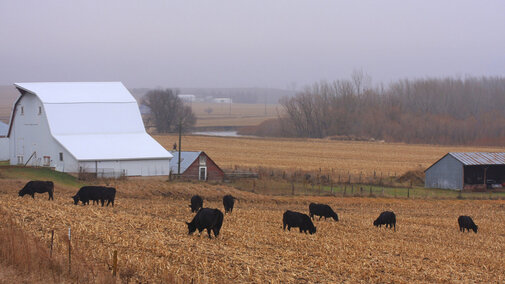Cattle Compaction in Cropland
Are you looking for additional income from your corn acres? Grazing corn residue is a low-cost winter feed source for cattle and a source of additional income for farmers without negative effects on the cropland.
Many crop producers are concerned that trampling from cattle grazing corn residue negatively affects crop yields. But when grazed at proper stocking rates, small but positive effects on crop production after grazing have been observed.
Research conducted at the University of Nebraska has shown that grazing corn residue at the recommended stocking rate does not reduce corn or soybean yields in irrigated fields the following growing season.
In fact, a long-term study in eastern Nebraska at the Eastern Research and Extension Center showed two to three bushel per acre improvements for soybean production following grazed corn residue in a corn-soybean rotation. This result was the same whether cattle grazed in the fall from November through January or spring from February through April.
A five-year study in western Nebraska measured corn yields from continuous corn after cattle grazing in the fall and found no negative effects on corn yields the following year.
It must be noted that minor surface compaction can result from grazing during wet weather. However, this compaction often disappears through the natural wetting and drying and freezing and thawing processes. And the compaction level for restricting root growth and does not carry over into the following growing season.
Grazing corn residue benefits both cattle and crop producers. Corn residue should be viewed as an economical source of winter roughage for cattle that can provide an extra source of income from corn production that does not affect next year's crop production.
Test Before Feeding Cornstalk Bales
Cornstalk bales will provide much needed feed this winter for many producers. If you’re one of them, be sure to feed them effectively.
Baled cornstalks are a great feed option to consider, especially with the current high price of hay. However, before you feed those bales, find out what they have to offer nutritionally. Sample and test your bales as soon as possible so when snow gets deep or other feeds run out, you will already know how to best feed your cornstalk bales.
Begin by testing the bales for protein and energy. You may be surprised at how variable the protein and energy content can be in cornstalk bales. I’ve seen protein as low as 3% and as high as 7%. Dry pregnant cows need 7%-8% protein in their diet so high protein bales will need only a little extra protein to adequately care for the cows. But those 3% bales will need quite a bit of supplement to keep cows in good condition.
Use a protein supplement that is nearly all natural and has sufficient rumen degradable protein. Maintenance-level forage diets need degradable protein for the rumen microbes, but remember that urea and other non-protein nitrogen sources aren’t used as well.
Many bales have pretty good TDN (total digestible nutrients) levels, nearly 6%. Cows fed these bales should do very well up until calving with just cornstalk bales and adequate protein supplement. However, stalks that were weathered before baling can be below 50% TDN. Cows fed these lower quality bales will need some extra energy, too.
If your bales came from stressed stalks, like from drought or hail, also get a nitrate test to be sure they are safe.
Good testing of cornstalk bales can help make them a nutritious and safe feed.

